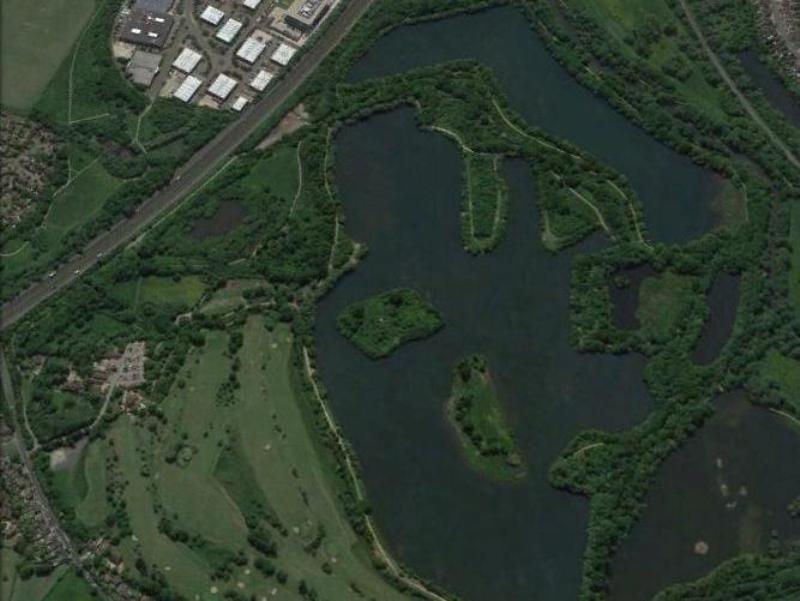Dinton Pastures Country Park was opened to the public in 1979, after 14 years of gravel extraction. The site had previously been farmland which belonged to High Chimneys Farm, shown in the 1974 pictures taken from the air in the gallery below. The farmhouse, built in 1904, is now the Dragonfly cafe and houses the Dinton Pastures Countryside Service offices. The name of Dinton Pastures was coined in 1924, when the land was sold to a farmer who re-named it after his home village of Dinton, near Aylesbury.
Prior to Dinton Pastures being created a number of lakes and pits did exist, some are much older than others, an article written by another local bird watcher – Dr Peter Gipson can be found here titled A history of Woodley Waters
Gravel extraction created eight lakes, with part of the Emm Brook diverted alongside what later became the golf course. Back in the early 80’s Sandford Lake was seen as the nature reserve, so the low islands were changed into gravel tern islands. This resulted in immediate successful breeding of 10+ pairs of Common Terns, with 1 or 2 pairs of Little-ringed Plover, Lapwing and Redshank as bonuses.
Several factors, including successive annual flooding of the lake in Spring, led to a re-think and in 1983 it was decided that the lake north of Sandford Lane, referred to until then as North Sandford, was a better location to provide protection against flooding and disturbance. Teal hide and the adjacent scrape were created in 1984, along with a new tern island and this site was named Lavell’s Lake that same year.
Once plans for a footpath along the nearby River Loddon went ahead, despite stringent objections about disturbance, there was little choice but to create a new, larger scrape at the East end of Lavell’s Lake. This became the Tern scrape and a larger hide was built alongside to offer good viewing for visitors.
- 1984 – Friends of Lavell’s Lake (FOLL) was formed to manage habitats of the area
- 1984 – Conservation area status given to Lavell’s Lake
- 1984 – Teal scrape dug and Teal hide constructed
- 1987 – FOLL became registered charity # 297074 and Lavell’s Lake given ‘local nature reserve’ status
- 1987 – Tern scrape excavated, Tern island created and Tern hide built. First phragmites reedbeds established
- 2000 – Major tree felling to remove overgrown poplars
- 2002 – First FOLL website launched
- 2003 – Began multiple phase, multiple lake phragmites reed expansion under the Countryside Stewardship Scheme
- 2004 – Outlined a basic habitat co-management agreement with owners Summerleaze Ltd for Lea Farm GP, along with members’ viewing rights
- 2004 – Last attempt to burn off and kill crassula at Teal Scrape
- 2004 – Dinton Pastures Countryside Services dug White Swan Lake phragmites expansion
- 2005 – Collaborated with Summerleaze Ltd to create a shingle island at Lea Farm GP
- 2005 – Agreement from Summerleaze Ltd and tenant farmer to offer sympathetic practices and restrict public access
- 2005 – Built 2 artificial Sand Martin walls, opposite Teal Scrape & at Lea Farm GP
- 2005 – Dug and re-profiled Teal scrape for phragmites expansion
- 2006 – Excavated phase 2 of main island phragmites expansion at Lavell’s Lake & invested in many new bird feeders
- 2007 – Countryside Stewardship Scheme grant obtained to help fund construction of a new hide, with tarmac ‘access for all’ path, to replace old Tern hide
- 2007 – Excavated phase 3 of main island phragmites expansion at Lavell’s Lake
- 2008 – New, bigger Bittern hide officially opened at Lavell’s Lake by Wokingham Borough Mayor Annette Drake on August 8th
- 2008 – Created a large winter feeding station around Bittern hide
- 2009 – Began construction of a restricted access hide on stilts overlooking Lea Farm GP
- 2010 – Mike Lowe, director of Summerleaze Ltd, officially opened the Ron Bryant hide at Lea Farm GP on June 11th
- 2015 – Viewing screen erected on north side of Sandford Lake by volunteers from Wincor Nixdorf, supported by FOLL members and Dinton Pastures Countryside Services staff
- 2015 – New FOLL website launched, incorporating a searchable database of bird records for members
- 2017-18 – with the help of a grant from Thames Water, the wetland habitat at Lavell’s Lake is extended with more reed-bed and marsh and the connectivity with Lea Farm Lake is improved.
- 2018 – FOLL becomes a Charitable Incorporated Organisation – Lavell’s Wetland Trust – in order to take its mission forward.
- 2020 – Trustee Ron Bryant donates Lea Farm Lake to the Trust. Work commences on a large wetland habitat creation project around the lake, supported by Network Rail’s partner Trust for Oxfordshire’s Environment (TOE).
- 2022 – LWT carries out excavator improvements on the North East shore. With 50% funding from Waitrose Woodley, a viewing screen with half roof and built in benches, built in the NW corner of Lea Farm Lake, now dedicated to our dearly departed friend Renton Righelato. A remembrance bench has also been built to remember our membership secretary Les Blundell.
- 2023 – LWT volunteers have a busy year making substantial progress across the nature reserves, bug hotels, improvements for disabled access to Ron’s hide, planted a mini orchard, more gorse in the SE corner. Notably, with a grant from Hurst Village Society, LWT built the long awaited Landfill View Point at the bottom of the car park field, again a bench, half roof and elbow rest, provide a great place to see over the landfill and right across North to upper Caversham, Shiplake and Bowsey Hill.




